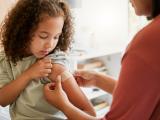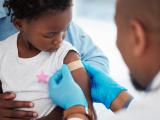Though school just started or is about to start in the United States, federal officials today issued "report cards" for some key immunization hallmarks, finding that state vaccine exemption levels are low and vaccination rates are high for kindergarteners.
In two reports issued today, the US Centers for Disease Control and Prevention (CDC) also said immunization rates are high for the nation's infants. The reports, which assess uptake of recommended childhood vaccines and other factors for 2014, appear today in the latest edition of Morbidity and Mortality Weekly Report (MMWR).
At a press briefing today, Anne Schuchat, MD, director of the CDC's National Center for Immunization and Respiratory Diseases, said that overall, the news is gratifying in that the overwhelming majority of parents continue to vaccinate their children. However, she warned that even small pockets of undervaccinated children can fuel an outbreak, such as the recent Disney-linked measles outbreak. Immunization programs count on high uptake not only to protect vaccinated children, but also to protect infants and those who can't be vaccinated for medical reasons.
The report on vaccine uptake in kindergarteners covers the 2014-15 school year. Median vaccination coverage was 94% for measles, mumps, and rubella (MMR) vaccine and 94.2% for local requirements for diphtheria, tetanus, and acellular pertussis (DTaP) vaccine. The levels were slightly below the national goal of 95%.
Also, the authors of the report looked at vaccine exemption levels, which stayed low at 1.7%. However, the levels varied by state, from a low of 0.1% in Mississippi to a high of 6.5% in Idaho. Five states did not meet the reporting standards for providing their exemption data.
Schuchat said a promising finding from the report is that an increasing number of states are providing vaccine-exemption data online. Compared with the previous year, the number grew by three, putting the number of states with that easily accessible number at 21. She said the CDC applauds states for making exemption information routinely available.
"Parents should know what's going on around them," she said.
The second report on infant vaccine uptake—centered on children ages 19 to 35 months—is based on a large survey, with vaccinations reported by parent respondents verified by the providers that vaccinated their children. Schuchat said it's the primary source CDC uses to gauge vaccination levels in younger children. "For another year, rates remain high," she said.
According to the new report, coverage remains high and at levels seen the previous year. Schuchat said the only notable change was increased uptake for hepatitis A vaccine, one of the newer childhood vaccines that the CDC is tracking.
Though hepatitis A uptake is still below the national goal, national targets were met last year for three or more doses of polio vaccine, one or more doses of MMR vaccine, three or more doses of hepatitis B vaccine, and one or more doses of varicella vaccine.
See also:
Aug 27 CDC press release
Aug 27 MMWR report on vaccine coverage in children ages 19 to 35 months
Aug 27 MMWR on vaccine coverage in kindergarteners





















